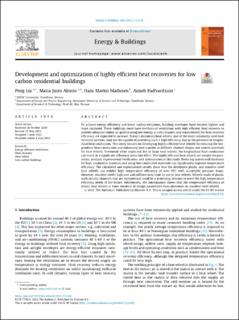| dc.contributor.author | Liu, Peng | |
| dc.contributor.author | Justo Alonso, Maria | |
| dc.contributor.author | Mathisen, Hans Martin | |
| dc.contributor.author | Halfvardsson, Anneli | |
| dc.date.accessioned | 2022-06-13T06:55:55Z | |
| dc.date.available | 2022-06-13T06:55:55Z | |
| dc.date.created | 2022-06-10T06:58:44Z | |
| dc.date.issued | 2022 | |
| dc.identifier.issn | 0378-7788 | |
| dc.identifier.uri | https://hdl.handle.net/11250/2998434 | |
| dc.description.abstract | To achieve energy efficiency and lower carbon emissions, building envelopes have become tighter and more insulated. These buildings must have mechanical ventilation with high efficient heat recovery to provide adequate indoor air quality using low energy in cold climates, and requirements for heat recovery efficiency are expected to increase. Today’s aluminum heat wheels, one of the most commonly used heat recovery systems, may not be capable of providing such a high efficiency due to the presence of longitudinal heat conduction. This study focuses on developing highly efficient heat wheels by reducing the longitudinal heat conduction and enhancing heat transfer in different channel shapes and matrix materials for heat wheels. Previously often neglected, but in large heat wheels, the longitudinal heat conduction can result in a significant efficiency reduction effect. The highly efficient heat wheels are sought via parametric analysis, experimental verification, and optimization in this study. Reducing matrix wall thickness for high conductive materials and using low conductive materials can significantly improve temperature efficiency. The calculated and experimental results show that the developed plastic and stainless steel heat wheels can exhibit high temperature efficiency of over 90% with acceptable pressure drops. However, stainless steel's high cost and stiffness may limit its use in heat wheels. Wheels made of plastic with circular channels that are symmetrical could be a promising solution to meet the high temperature efficiency needs of the future. Additionally, the optimization shows that the temperature efficiency of plastic heat wheels is more sensitive to design parameters than aluminum or stainless-steel wheels. | en_US |
| dc.language.iso | eng | en_US |
| dc.publisher | Elsevier | en_US |
| dc.rights | CC BY 4.0 | * |
| dc.rights.uri | http://creativecommons.org/licenses/by/4.0/ | * |
| dc.subject | Energy efficient ventilation | en_US |
| dc.subject | Heat recovery | en_US |
| dc.subject | Heat wheel | en_US |
| dc.subject | Low-carbon buildings | en_US |
| dc.title | Development and optimization of highly efficient heat recoveries for low carbon residential buildings | en_US |
| dc.title.alternative | Development and optimization of highly efficient heat recoveries for low carbon residential buildings | en_US |
| dc.type | Peer reviewed | en_US |
| dc.type | Journal article | en_US |
| dc.description.version | publishedVersion | en_US |
| dc.rights.holder | © 2022 The authors | en_US |
| dc.subject.nsi | VDP::Teknologi: 500 | en_US |
| dc.source.volume | 268 | en_US |
| dc.source.journal | Energy and Buildings | en_US |
| dc.identifier.doi | 10.1016/j.enbuild.2022.112236 | |
| dc.identifier.cristin | 2030645 | |
| dc.relation.project | Norges forskningsråd: 256474 | en_US |
| dc.source.articlenumber | 112236 | en_US |
| cristin.ispublished | true | |
| cristin.fulltext | original | |
| cristin.qualitycode | 2 | |

